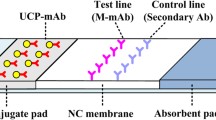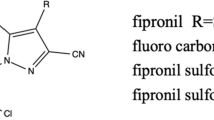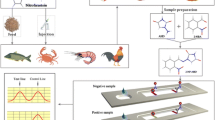Abstract
Sudan dyes have been found to be added to chilli and chilli products for illegal colour enhancement purposes. Due to the possible carcinogenic effect, they are not authorized to be used in food in the European Union or the USA. However, over the last few years, many products imported from Asian and African countries have been reported via the Rapid Alert System for Food and Feed in the European Union to be contaminated with these dyes. In order to provide fast screening method for the detection of Sudan I (SI), which is the most widely abused member of Sudan dyes family, a unique (20 min without sample preparation) direct disequilibrium enzyme-linked immunosorbent assay (ELISA) was developed. The assay was based on polyclonal antibodies highly specific to SI. A novel, simple gel permeation chromatography clean-up method was developed to purify extracts from matrices containing high amounts of fat and natural pigments, without the need for a large dilution of the sample. The assay was validated according to the Commission Decision 2002/657/EC criteria. The detection capability was determined to be 15 ng g−1 in sauces and 50 ng g−1 in spices. The recoveries found ranged from 81% to 116% and inter- and intra-assay coefficients of variation from 6% to 20%. The assay was used to screen a range of products (85 samples) collected from different retail sources within and outside the European Union. Three samples were found to contain high amounts (1,649, 722 and 1,461 ng g−1) of SI by ELISA. These results were confirmed by liquid chromatography-tandem mass spectrometry method. The innovative procedure allows for the fast, sensitive and high throughput screening of different foodstuffs for the presence of the illegal colorant SI.

Figure (A) Typical standard curve obtained with a rapid disequilibrium Sudan I ELISA, (B) structure of Sudan I and (C) gel permeation chromatography procedure for the clean-up of spices samples





Similar content being viewed by others

References
Calbiani F, Careri M, Elviri L, Mangia A, Pistarà L, Zagnoni I (2004) Development and in-house validation of a liquid chromatography–electrospray–tandem mass spectrometry method for the simultaneous determination of Sudan I, Sudan II, Sudan III and Sudan IV in hot chilli products. J Chromatogr A 1042:123–130
Cornet V, Govaert Y, Moens G, Van Loco J, Degroodt JM (2006) Development of a fast analytical method for the determination of Sudan dyes in chili- and curry-containing foodstuffs by high-performance liquid chromatography-photodiode array detection. J Agric Food Chem 54:639–644
Møller P, Wallin H (2000) Genotoxic hazards of azo pigments and other colorants related to 1-phenylazo-2-hydroxynaphthalene. Mutat Res 462:13–30
Downham A, Collins P (2000) Colouring our foods in the last and next millennium. Int J Food Sci Tech 35:5–22
Perva-Uzunalić A, Škerget M, Weinreich B, Željko K (2004) Extraction of chilli pepper (var. Byedige) with supercritical CO2: effect of pressure and temperature on capsaicinoid and colour extraction efficiency. Food Chem 87:51–58
EU (1994) European Parliament and Council Directive 94/36/EC of 30 June 1994 on colours for use in foodstuffs. Off J Eur Comm L237:13–29
European Food Safety Authority (EFSA) (2005) Opinion of the Scientific Panel on Food Additives, Flavourings, Processing Aids and Materials in Contact with Food on a request from the Commission to Review the toxicology of a number of dyes illegally present in food in the EU. The EFSA J 263:1–71
International Agency for Research on Cancer (IARC) (1975) IARC Monographs on the evaluation of carcinogenic risks to humans. Some aromatic azo compunds. IARC, Lyon, vol. 8. Available at http://monographs.iarc.fr/ENG/Monographs/vol8/volume8.pdf. Accessed 1 Sep 2009
National Toxicology Program (NTP) (1982) Carcinogenesis bioassay of C.I. Solvent Yellow 14 (CAS NO. 842-07-9) in F344/N rats and B6C3F1 mice (feed study). Technical Report Series No. 226. Available at http://ntp.niehs.nih.gov/ntp/htdocs/LT_rpts/tr226.pdf. Accessed 26 Aug 2010
EU (2003) Commission Decision of 20 June 2003 on emergency measures regarding hot chilli and hot chilli products (2003/460/EC). Off J Eur Union L154:114–115
EU (2004) Commission Decision of 21 January 2004 on emergency measures regarding chilli and chilli products (2004/92/EC). Off J Eur Union L27:52–54
EU (2005) Commission Decision of 23 May 2005 on emergency measures regarding chilli, chilli products, curcuma and palm oil (2005/402/EC). Off J Eur Union L135:34–36
EU (2006) Commission Directive 2006/33/EC of 20 March 2006 amending Directive 95/45/EC as regards sunset yellow FCF (E 110) and titanium dioxide (E 171). Off J Eur Union L82:10–13
Stiborova M, Martinek V, Rydlova H, Hodek P, Frei E (2002) Sudan I is a potential carcinogen for humans: evidence for its metabolic activation and detoxication by human recombinant cytochrome P450 1A1 and liver microsomes. Cancer Res 62:5678–5684
Golka K, Kopps S, Myslak ZW (2004) Carcinogenicity of azo colorants: influence of solubility and bioavailability. Toxicol Lett 151:203–210
Xu H, Heinze TM, Chen S, Cerniglia CE, Chen H (2007) Anaerobic metabolism of 1-amino-2-naphthol-based azo dyes (Sudan dyes) by human intestinal microflora. Appl Environ Microb 73:7759–7762
Pielesz A, Baranowska I, Rybak A, Wlochowicz A (2002) Detection and determination of aromatic amines as products of reductive splitting from selected azo dyes. Ecotox Environ Safe 53:42–47
Rapid Alert System For Food and Feed (RASFF) Online database. Available at https://webgate.ec.europa.eu/rasff-window/portal/
Ertaş E, Özer H, Alasalvar C (2007) A rapid HPLC method for determination of Sudan dyes and Para Red in red chilli pepper. Food Chem 105:756–760
Liu W, Zhao W, Chen J, Yang M (2007) A cloud point extraction approach using Triton X-100 for the separation and preconcentration of Sudan dyes in chilli powder. Anal Chim Acta 605:41–45
Mazzetti M, Fascioli R, Mazzoncini I, Spinelli G, Morelli I, Bertoli A (2004) Determination of 1-phenylazo-2-naphthol (sudan I) in chilli powder and in chilli-containing food products by GPC clean-up and HPLC with LC/MS confirmation. Food Addit Contam 21:935–941
Mazzotti F, Di Donna L, Maiuolo L, Napoli A, Salerno R, Sajjad A, Sindona G (2008) Assay of the set of all Sudan azodye (I, II, III, IV, and Para-red) contaminating agents by liquid chromatography–tandem mass spectrometry and isotope dilution methodology. J Agr Food Chem 56:63–67
Pardo O, Yusà V, León N, Pastor A (2009) Development of a method for the analysis of seven banned azo-dyes in chilli and hot chilli food samples by pressurised liquid extraction and liquid chromatography with electrospray ionization-tandem mass spectrometry. Talanta 78:178–186
Calbiani F, Careri M, Elviri L, Mangia A, Zagnoni I (2004) Accurate mass measurements for the confirmation of sudan azo-dyes in hot chilli products by capillary liquid chromatography–electrospray tandem quadrupole orthogonal-acceleration time of flight mass spectrometry. J Chromatogr A 1058:127–135
Tateo F, Bononi M (2004) Fast determination of Sudan I by HPLC/APCI-MS in hot chilli, spices, and oven-baked foods. J Agr Food Chem 52:655–658
Uematsu Y, Ogimoto M, Kabashima J, Suzuki K, Kouichi I (2007) Fast cleanup method for the analysis of Sudan I-IV and Para red in various foods and paprika color (oleoresin) by high-performance liquid chromatography/diode array detection: focus on removal of fat and oil as fatty acid methyl esters prepared by transesterification of acylglycerols. J AOAC Int 90:437–445
He L, Su Y, Fang B, Shen X, Zeng Z, Liu Y (2007) Determination of Sudan dye residues in eggs by liquid chromatography and gas chromatography–mass spectrometry. Anal Chim Acta 594:139–146
Du M, Han X, Zhou Z, Wu S (2007) Determination of Sudan I in hot chili powder by using an activated glassy carbon electrode. Food Chem 105:883–888
Gan T, Li K, Wu K (2008) Multi-wall carbon nanotube-based electrochemical sensor for sensitive determination of Sudan I. Sensor Actuator B 132:134–139
Lin H, Li G, Wu K (2008) Electrochemical determination of Sudan I using montmorillonite calcium modified carbon paste electrode. Food Chem 107:531–536
Mejia E, Ding YS, Mora MF, Garcia CD (2007) Determination of banned Sudan dyes in chili powder by capillary electrophoresis. Food Chem 102:1027–1033
Anfossi L, Baggiani C, Giovannoli C, Giraudi G (2009) Development of enzyme-linked immunosorbent assays for Sudan dyes in chilli powder, ketchup and egg yolk. Food Addit Contam Part A 26:800–887
Han D, Yu M, Knopp D, Niessner R, Wu M, Deng A (2007) Development of a highly sensitive and specific enzyme-linked immunosorbent assay for detection of Sudan I in food samples. J Agr Food Chem 55:6424–6430
Wang Y, Wei D, Yang H, Yang Y, Xing W, Li Y, Deng A (2009) Development of a highly sensitive and specific monoclonal antibody-based enzyme-linked immunosorbent assay (ELISA) for detection of Sudan I in food samples. Talanta 77:1783–1789
Xu T, Wei KY, Wang J, Eremin SA, Liu SZ, Li QX, Li J (2010) Development of an enzyme-linked immunosorbent assay specific to Sudan red I. Anal Biochem 405:41–49
Ju C, Tang Y, Fan H, Chen J (2008) Enzyme-linked immunosorbent assay (ELISA) using a specific monoclonal antibody as a new tool to detect Sudan dyes and Para red. Anal Chim Acta 621:200–206
Xu J, Zhang Y, Yi J, Meng M, Wan Y, Feng C, Wang S, Lu X, Xi R (2010) Preparation of anti-Sudan red monoclonal antibody and development of an indirect competitive enzyme-linked immunosorbent assay for detection of Sudan red in chilli jam and chilli oil. Analyst 13:2566–2572
Aslam M, Dent A (1998) Bioconjugation, protein coupling techniques for the biomedical sciences. Macmillan Reference Ltd., London, pp 416–418, pp 448–450, 793
Fodey TL, Delahaut P, Elliott CT (2007) Use of antigen mimics to produce specific antibodies to anti-coccidial drugs. J Immunol Method 323:31–38
EU (2002) Commission Decision 2002/657/EC of 12 August 2002 implementing Council Directive 96/23/EC concerning the performance of analytical methods and the interpretation of results. Off J Eur Comm L221:8–36
Scortichini G, Annunziata L, Haouet M, Benedetti F, Krusteva I, Galarini R (2005) ELISA qualitative screening of chloramphenicol in muscle, eggs, honey and milk: method validation according to the Commission Decision 2002/657/EC criteria. Anal Chim Acta 535:43–48
Cooper KM, Samsonova JV, Plumpton L, Elliott CT, Kennedy DG (2007) Enzyme immunoassay for semicarbazide—the nitrofuran metabolite and food contaminant. Anal Chim Acta 592:64–71
Hoenicke K, Gatermann R, Hartig H, Reimann L (2005) Detection of eight sudan dyes, Dimethyl Yellow, Para Red, Orange II and Rhodamine B, in spices and food using LC-MS/MS. Poster Presentation at AOAC annual meeting in Orlando
Nakamura RM (1992) In: Nakamura RM, Kasahara Y, Rechnitz GA (eds) Immunochemical assays and biosensor technology for the 1990s, ch. 1. American Society for Microbiology, Washington, p 11
Venkatesh N, Murthy GS (1996) Dissociation of monoclonal antibody-antigen complexes: implication for ELISA procedures. J Immunol Method 199:167–174
Kuo JKS, Silverman GJ (1980) Application of enzyme-linked immunosorbent assay for detection of staphylococcal enterotoxins in food. J Food Protect 43:404–407
Rumbo M, Chirdo FG, Fossati CA, Añón MC (1996) Analysis of structural properties and immunochemical reactivity of heat-treated ovalbumin. J Agric Food Chem 44:3793–3798
Rozenfeld P, Docena GH, Añón MC, Fossati CA (2002) Detection and identification of a soy protein component that cross-reacts with caseins from cow’s milk. Clin Exp Immunol 130:49–58
Goulart SM, de Queiroz MELR, Neves AA, de Queiroz JH (2008) Low-temperature clean-up method for the determination of pyrethroids in milk using gas chromatography with electron capture detection. Talanta 75:1320–1323
Tran VK, Young MS, Neue U (2005) Effective SPE strategies for LC-MS determination of sudan dyes in chilli products. Waters Corporation, Milford. Available at http://www.waters.com/webassets/cms/library/docs/wa43184.pdf. Accessed 1 May 2009
Anastassiades M (2005) A mini-multiresidue method for the analysis of pesticide residues in low-fat products. Available at http://www.quechers.com. Accessed 1 Feb 2011
Salgado-Roman M, Botello-Álvarez E, Rico-Martínez R, Jiménez-Islas H, Cárdenas-Manríquez M, Navarrete-Bolaños JL (2008) Enzymatic treatment to improve extraction of capsaicinoids and carotenoids from chili (Capsicum annuum) fruits. J Agr Food Chem 56:10012–10018
Orhan I, Eryilmaz B, Bingöl F (2002) A comparative study on the fatty acid contents of Capsicum annuum varieties. Biochem Syst Ecol 30:901–904
Mutter M (1969) Analysis of anionic detergents by liquid chromatography using Sephadex G-10 columns. Chromatographia 2:208–211
Food and Agriculture Organization (FAO) and World Health Organization (WHO) (2009) Principles and methods for the risk assessment of chemicals in food, Ch. 7. Risk characterization. Available at http://whqlibdoc.who.int/ehc/WHO_EHC_240_10_eng_Chapter7.pdf. Accessed 25 Aug 2010
European Food Safety Authority (EFSA) (2005) Opinion of the Scientific Committee on a request from EFSA related to a harmonised approach for risk assessment of substances which are both genotoxic and carcinogenic. The EFSA Journal 282:1–31
Coulet M, Leblanc J-C, Setzer RW (2010) Application of the margin of exposure (MoE) approach to substances in food that are genotoxic and carcinogenic: EXAMPLE 12: Sudan I (CAS No. 842-07-9). Food Chem Toxicol 48:S106–S111
World Health Organization (WHO) (2006) GEMS/food consumption cluster diets. Available at http://www.who.int/foodsafety/chem/gems/en/index1.html. Accessed 25 Aug 2010
Acknowledgements
The authors wish to thank Neogen Corporation, USA for funding this study. They also wish to thank Dr. Sam Mitchell and Mr. Colin McRoberts, AFBI, Belfast for their technical advice and Mr. Stephen Holmes, The Food and Environment Research Agency, York for providing food samples.
Author information
Authors and Affiliations
Corresponding authors
Electronic supplementary material
Below is the link to the electronic supplementary material.
ESM 1
(PDF 186 kb)
Rights and permissions
About this article
Cite this article
Oplatowska, M., Stevenson, P.J., Schulz, C. et al. Development of a simple gel permeation clean-up procedure coupled to a rapid disequilibrium enzyme-linked immunosorbent assay (ELISA) for the detection of Sudan I dye in spices and sauces. Anal Bioanal Chem 401, 1411–1422 (2011). https://doi.org/10.1007/s00216-011-5185-y
Received:
Revised:
Accepted:
Published:
Issue Date:
DOI: https://doi.org/10.1007/s00216-011-5185-y



